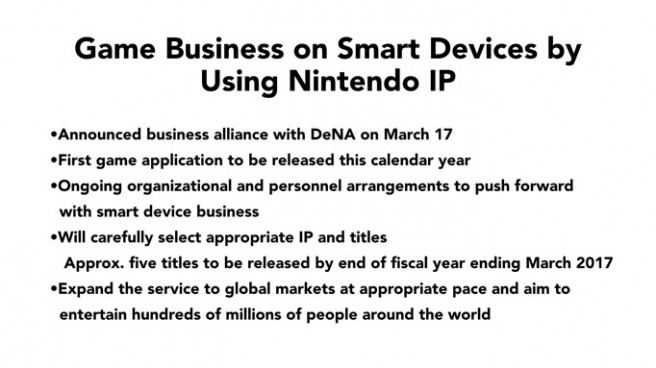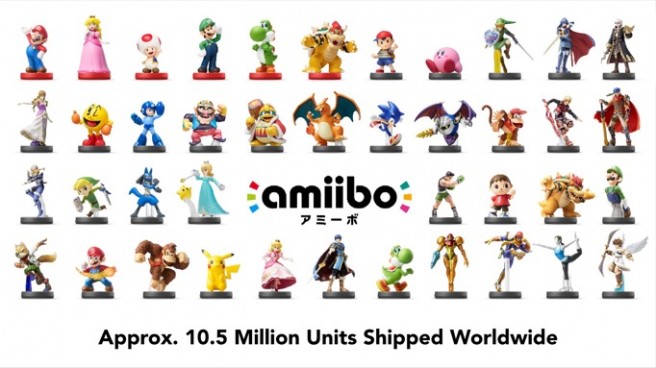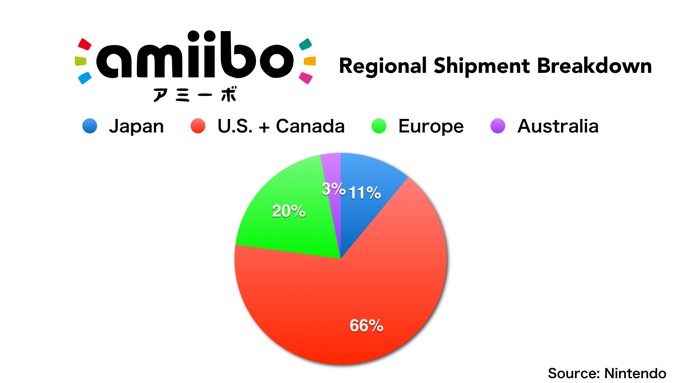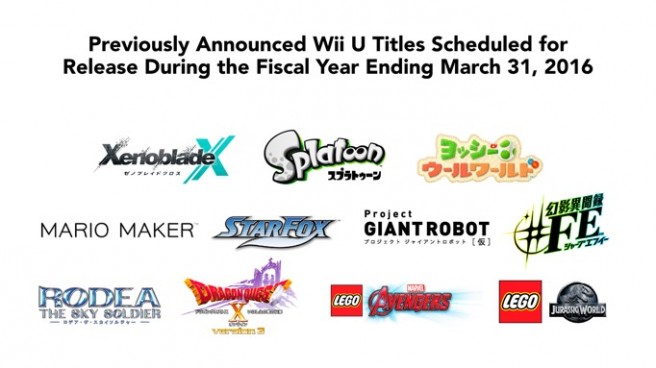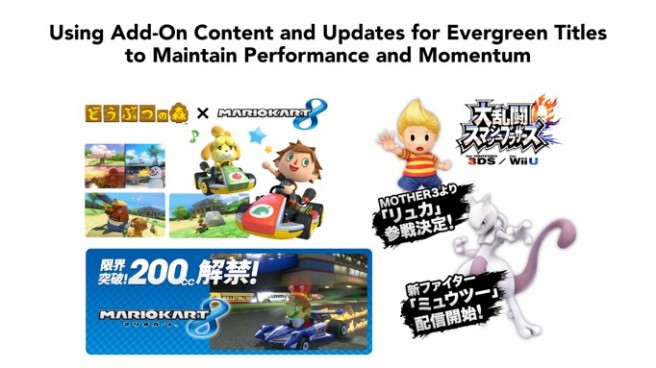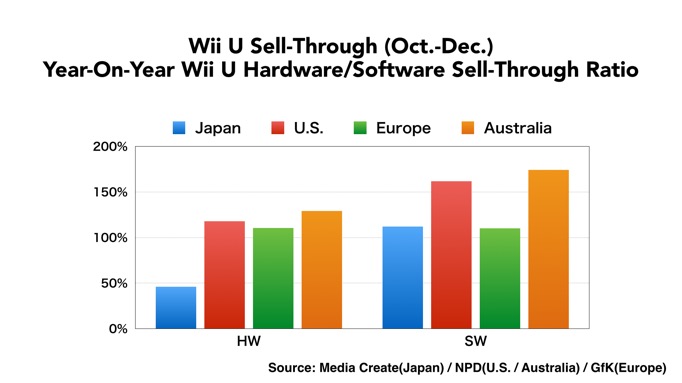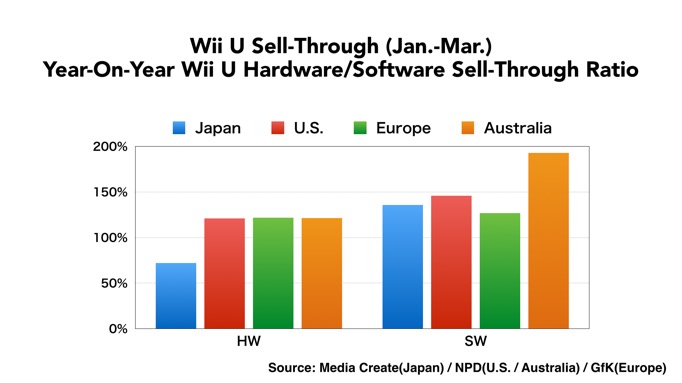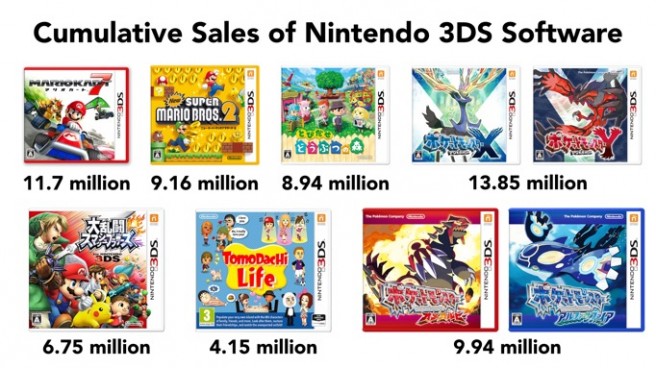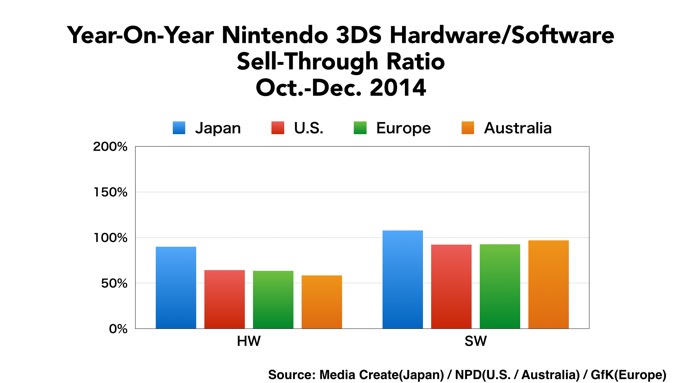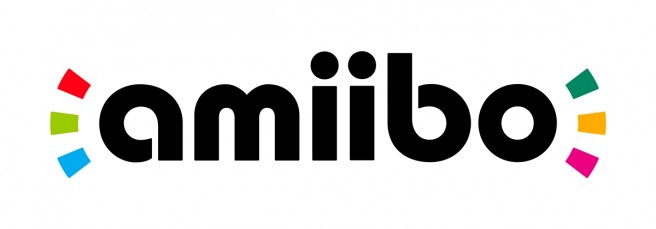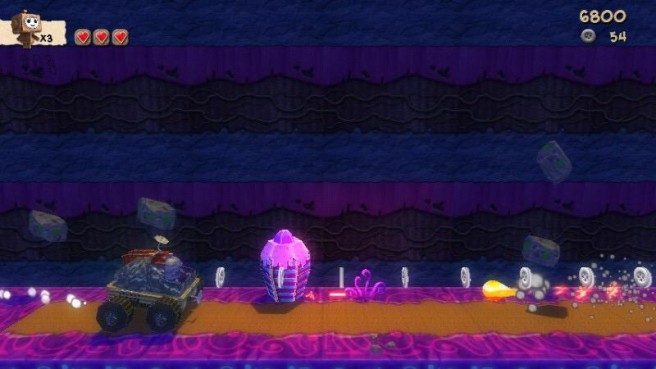Nintendo talks new membership service, will show past purchases and gameplay records
Posted on 9 years ago by Brian(@NE_Brian) in News | 19 Comments
On the other hand, Nintendo continues to have strong passion and believes in the promising prospects for the future of our dedicated video game system business. We will deploy our game business on smart devices not because we think that the dedicated game system business will wane, but because doing so will encourage a greater number of people to associate with Nintendo IP, to become familiar with the charms of video games and, eventually, to explore more premium experiences on our dedicated game systems. To realize this, we need to create a bridge between the two platforms.
When we announced our business alliance with DeNA, we announced an “integrated membership service,” with the mission of establishing a bridge between smart devices and dedicated game systems. The membership service will encompass multiple devices such as our existing Nintendo 3DS, Wii U, the dedicated game system NX, which is currently under development, smart devices and PCs.
While we will announce the details of this integrated membership service at a later date, I can share with you at a high level the idea is that the consumer can access multiple devices using one common ID.
For us to be able to bridge the gap between smart devices and dedicated game systems, we will offer advantages to consumers who use one ID across multiple devices.So far, the members input their Club Nintendo ID to use the services. With this new service, our members will be able to visit Nintendo’s website and log in with one ID, and they will receive various services including the ones based on their past purchases and gameplay records as well as services that will be an improved version of the current loyalty program.
With this new membership, we are planning to deploy services that will make playing Nintendo games with their game pals more fun regardless of which platform they are accessing.
Iwata on maximizing Nintendo’s IP, mobile plans
Posted on 9 years ago by Brian(@NE_Brian) in Mobile, News | 2 Comments
And now, I would like to discuss our future business developments.
Right now, the game business is undergoing significant change. The spread of the Internet and social media has dramatically changed the lifestyles of people all over the world, and Nintendo is adjusting its strategic endeavors in line with the new market dynamics.
For one thing, in order to maximize the value of Nintendo IP, we are working to leverage opportunities that go beyond a traditional focus on dedicated video game systems. As you know, amiibo is one such effort. Also, we made the announcement that we will take advantage of smart devices. As smart devices are increasing in significance as the dominant window through which consumers connect with one another and with society, it is natural for us to leverage smart devices to communicate directly with our consumers.
In addition, to facilitate the ability for consumers to be closely and continuously connected with Nintendo IP, Nintendo will also deploy Nintendo IP on games for smart devices.
Regarding this subject, we announced our business alliance with DeNA on March 17. Each of our companies offers unique strengths, and we are confident that when combined, the synergies will enable us to compete strongly in the smart device space.
We will start the service for the first game application by the end of this calendar year. Internally at Nintendo, we have executed several organizational and personnel changes in order to properly operate the smart device business, and we will make further changes before the first release.
As we confirmed on March 17, all of our IP can be considered for a smart device game. On the other hand, since the game business on smart devices is already severely competitive, even with highly popular IP, the odds of success are quite low if consumers cannot appreciate the quality of a game. Also, if we were simply to port software that already has a track record on a dedicated game system, it would not match the play styles of smart devices, and the appropriate business models are different between the two, so we would not anticipate a great result. If we did not aim to achieve a significant result, it would be meaningless for us to do it at all. Accordingly, we are going to carefully select appropriate IP and titles for our smart device deployment.
Regarding the number of the titles, you may want to know that we will release approximately five titles by the end of the next fiscal year, which is the end of March 2017. You may think it is a small number, but when we aim to make each title a hit, and because we want to thoroughly operate every one of them for a significant amount of time after their releases, this is not a small number at all and should demonstrate our serious commitment to the smart device business.
We will strive to expand this business into global markets at a steady pace so that eventually we will entertain hundreds of millions of people all around the world. We are aiming to make this one of the pillars of Nintendo’s revenue structure.
More: Satoru Iwata, top
Iwata on Nintendo’s download sales
Posted on 9 years ago by Brian(@NE_Brian) in General Nintendo, News | 3 Comments
These graphs show the download sales transitions in the recent three fiscal years. In the just-ended financial year, following on from the third quarter, the fourth-quarter download sales grew dramatically and the total download sales for the full fiscal year reached 31.3 billion yen. The digital download sales increase of about 30 percent compared to the previous fiscal year should be mainly attributable to such facts as the sales of the digital versions of both the Nintendo 3DS and Wii U software increasing, especially in the overseas markets.
More: sales, Satoru Iwata, top
Iwata’s full comments on amiibo sales, shortages
Posted on 9 years ago by Brian(@NE_Brian) in General Nintendo, News | 0 comments
We launched a new product category – amiibo – simultaneously with “Super Smash Bros for Wii U,” and the end of the subject fiscal term marked a total shipment of approximately 10.5 million units worldwide. As we had shipped approximately 5.7 million units by the end of calendar year 2014, it is safe to say that we achieved very strong growth even in the period immediately after the year-end sales season was over. Our assessment is that people purchase additional amiibo figures without any seasonal bias, as they are relatively more affordable than video game titles.
Our consumers have been inconvenienced by stock shortages on some of the figures in our amiibo lineup. We have increased production for amiibo figures that have sold out very quickly after launch, that are indispensable to play a certain game and for which we have received strong demand from retailers and consumers. However, we are very sorry that we can?t promise at what point we will likely be able to resolve the current situation because figures such as these require a considerable amount of time to produce, store shelf space is limited and it is difficult to precisely predict the exact amount of overall demand.
On the other hand, the number of software titles compatible with amiibo is increasing and consumers’ recognition and understanding for amiibo has improved significantly compared to the launch period, so we believe that we can predict further sales growth.
This pie graph shows the most recent regional shipment breakdown of amiibo. The U.S. and Canada, shown in red in the graph, have an overwhelmingly large 66 percent share, showing a tremendous presence overall.
In addition to figure offerings in the amiibo lineup this year, we are planning to release Yarn Yoshi amiibo and card-type amiibo. The first software title that is compatible with these amiibo cards is “Animal Crossing: Happy Home Designer,” which for Nintendo 3DS. Simultaneously, we will also launch the “Nintendo 3DS NFC Reader/Writer” so that not only the owners of New Nintendo 3DS, which is equipped with NFC functionality, but also the owners of the original Nintendo 3DS systems can play with amiibo. The NFC Reader/Writer enables consumers to play with amiibo on the original Nintendo 3DS systems, and we believe we can expect further growth in amiibo sales with this significant increase in the number of compatible hardware systems.
More: Amiibo, Satoru Iwata, top
Partial look at Wii U’s upcoming lineup of titles
Posted on 9 years ago by Brian(@NE_Brian) in News, Wii U | 16 Comments
Update: Bumped to the top. Post now has the English slide. Also, full comments from Iwata about Wii U’s lineup:
These are the already announced Wii U titles that will be released in the fiscal year ending March 31, 2016, and there are also unannounced titles that are not listed here. Among these titles, there are games that actively utilize the Wii U GamePad, including several we showed at E3 last year that are considered part of the Wii U GamePad utilization project led by Mr. Miyamoto.
In the case of other such titles as “Mario Maker (temp.),” I believe that the type of gameplay that lets consumers use the GamePad to take advantage of their creativity to create UGC (user-generated content) for everyone to enjoy offers tremendous possibilities, and I also believe that the nature of the gameplay that encourages parents and children to play together has great potential as well.
Nintendo included a slide in its latest financial results briefing that provides a look at upcoming titles for Wii U. Take a look at the image above.
Iwata: Wii U maintaining momentum to begin 2015, importance of keeping evergreen games fresh
Posted on 9 years ago by Brian(@NE_Brian) in News, Wii U | 2 Comments
Wii U is maintaining momentum even after the start of the new year, especially in the overseas markets.
This is the year-on-year Wii U hardware/software sell-through ratio for the October-December period we showed at the Third Quarter Financial Results Briefing.
The momentum gained during the year-end continued into the fourth quarter.
As the ratios show, software in all regions and hardware in the overseas markets exceeded those of the previous year.
Our analysis is that this increase is not so much owed to the release of new titles but instead to the release of two classic multiplayer titles for Nintendo’s home console last year.
Specifically, I believe it was significant that “Mario Kart 8” and “Super Smash Bros. for Wii U” were released in the same year and that we have been able to maintain users’ active use of these titles months after their respective releases.
We are trying to motivate our consumers to continually play the games that they have purchased and are placing emphasis on the ability to keep a high replay value even after time has passed since their release by adding new functionalities via software updates or by digitally offering new add-on content such as new characters and new courses. This is an important effort for maintaining the performance and momentum of evergreen titles and further extending their lifespan.
Iwata on 3DS software, evergreen sales, more
Posted on 9 years ago by Brian(@NE_Brian) in 3DS, News | 0 comments
In the video game platform business, although people tend to focus on the huge spike of sales immediately after a game release, looking back at the history of Nintendo’s handheld game systems, not only does hardware sell well with new titles, but our systems also tend to sell well paired with big titles that have become evergreen.
This tendency is strongest in the overseas markets, and we will aim to expand our hardware by promoting new titles as well as retaining the energy of our abundant evergreen titles (which are not new on the market but maintain consistent sales.)
These are the cumulative sales figures of some of the Nintendo 3DS software sold so far. Although “Mario Kart 7” was released in 2011, “New Super Mario Bros. 2” and “Animal Crossing: New Leaf” were in 2012 and “Pokémon X” and “Pokémon Y” were released in 2013, each of these titles sold more than 1 million units in the subject fiscal year. In the overseas markets especially, many titles tend to become evergreen and sell consistently even long after their releases.
“Super Smash Bros. for Nintendo 3DS” was released in fall last year and sold 6.75 million copies by the end of the subject fiscal year. “Tomodachi Life” was released in Japan in November 2013 and in the subject fiscal year overseas, and it sold particularly well in Europe with the global cumulative shipment reaching 4.15 million units. Also, from their release in November last year to the end of the subject fiscal term, 9.94 million units of “Pokémon Omega Ruby” and “Pokémon Alpha Sapphire” were shipped. While on one hand, we will keep these titles evergreen and on another we will add new quality software, we aim to further expand the sales of Nintendo 3DS hardware by increasing its broad software lineup.
In addition, as I mentioned in my presentation for the last Financial Results Briefing, we are working on further promoting multiplayer gameplay using the local communication function of Nintendo 3DS in the overseas markets as well. This shall play a major role for franchises such as “Mario Kart,” “Animal Crossing,” “Super Smash Bros.,” “Pokémon,” “Monster Hunter” and for the “YO-KAI WATCH” game, which will be released in overseas markets in the future.
More: sales, Satoru Iwata, top
Iwata on 3DS hardware sales, planning titles that can appeal to women
Posted on 9 years ago by Brian(@NE_Brian) in 3DS, News | 9 Comments
This is the graph displayed in the last Financial Results Briefing, which shows the percentage of change found in the sell-through data of Nintendo 3DS hardware and software in each market for the third quarter of this fiscal year compared to the corresponding term of the previous year.
As you can see, except for Japan, where New Nintendo 3DS contributed to the full quarter, the hardware sales fell far short of the previous year in the U.S. and Europe where the new models were not available during the third quarter and in Australia, where they were launched in late November.
In the fourth quarter, you can see the launch of New Nintendo 3DS in the overseas markets boosted the sales of both hardware and software from one year prior and brought momentum to the platform once again.
On the other hand, the Japanese market was in between big titles and this resulted in a different outcome after having enjoyed five double-million sellers in the latter six months of the year 2014.
In the Japanese market, the cumulative sales of Nintendo 3DS hardware since its launch are about to reach 19 million units. Regarding the Nintendo 3DS software market, the situation remains promising not only because there have been numerous major-hit titles released since the latter half of last year, but also because we have high hopes for the many titles that are planned to be released this year by both Nintendo and other game software developers. On the other hand, regarding the Nintendo 3DS hardware, four years since its release, we are seeing a certain level of positive results by the release of New Nintendo 3DS, but we still have not been able to break free from the period beyond the popularization of the Nintendo 3DS in which the performance leveled off. I believe that the key to revitalizing the Nintendo 3DS business in Japan is by intensifying its appeal to even more generations of female consumers.
This year, we are planning to release titles that offer high potential to appeal to female consumers, and we would like to further strengthen our approach to reach a female audience covering wider generations.
Meanwhile, in the overseas markets, the Nintendo 3DS hardware has not spread to a level where it has reached its market potential. In other words, there is plenty of room for growth.
Since the release of New Nintendo 3DS in February this year, especially for the large-screened New Nintendo 3DS XL, stock in stores has continued to run low in the U.S. and Europe, which of course is a sign that the game platform has momentum.
More: sales, Satoru Iwata, top
Iwata again says amiibo are being restocked, unsure when the stock situation will be resolved
Posted on 9 years ago by Brian(@NE_Brian) in News | 9 Comments
Nintendo president Satoru Iwata once again weighed in on the amiibo stock situation during the company’s financial results briefing today.
Iwata is aware that some figures are selling out, which is causing inconvenience for customers. However, supply is increasing for amiibo that have become rare, are needed for play, or are highly requested at stores.
Iwata stated that a date can’t be promised as to when the situation will be resolved. This is due to the fact that amiibo take time to produce, shelf space is limited, and Nintendo can’t predict how much demand there is.
Paper Monsters Recut update live in North America
Posted on 9 years ago by Brian(@NE_Brian) in News, Wii U eShop | 0 comments
The newest Paper Monsters Recut update is now live in North America. Once applied, players should find a much smoother experience thanks to the elimination of certain bugs.
Developer Mobot Studios passed along the update news on Twitter:
Paper Monsters Recut #WiiU patch is finally live for North America! Buggy Blast Away! pic.twitter.com/q1V0HpsveT
— Fletcher (@MobotStudios) May 8, 2015
Paper Monsters Recut’s update previously came to Europe in March.
Thanks to Cameron for the tip.

